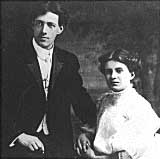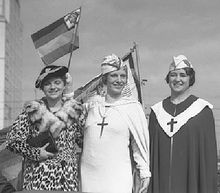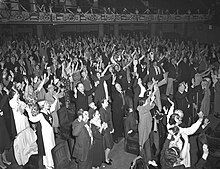Aimee Semple McPherson
[13] As a teenager, McPherson strayed from her mother's teachings by reading novels and attending movies and dances, activities disapproved by the Salvation Army and her father's Methodist religion.
[citation needed] In 1917, she started a magazine, Bridal Call, for which she wrote articles about women's roles in religion; she portrayed the link between Christians and Jesus as a marriage bond.
McPherson used the experience as the narrative of an illustrated sermon called "The Heavenly Airplane",[65] featuring the devil as pilot, sin as the engine, and temptation as propeller.
McPherson gave up to 22 sermons a week, including lavish Sunday night services so large that extra trolleys and police were needed to help route the traffic through Echo Park.
[80] In 1916, before a gathered revival tent crowd, Aimee experienced swift rejuvenation of blistered skin from a serious flash burn caused by a lamp that had exploded in her face.
A young woman in the advanced stages of rheumatoid arthritis was brought to the altar by friends just as McPherson preached "Jesus Christ is the same yesterday, today and forever".
[87][88] At a revival meeting in August 1921, in San Francisco, journalists posing as scientific investigators diverted healing claimants as they descended from the platform and "cross-examined as to the genuineness of the cure."
[89][90] In 1921 during the Denver campaign, a Serbian Romani tribe chief, Dewy Mark and his mother stated they were faith-healed by McPherson of a respiratory illness and a "fibroid tumor."
McPherson interrupted the speaker, raised her hand to the sky, and prayed, "if the land hath need of it, let it fall (the rain) after the message has been delivered to these hungry souls".
[101] In April 1920, a Washington Times reporter conveyed that for McPherson's work to be a hoax on such a grand scale was inconceivable, communicating that the healings were occurring more rapidly than he could record them.
[112] Actor Anthony Quinn, who for a time played in the church's band and was an apprentice preacher, in this partial quote, recalls a service: I sat in the orchestra pit of the huge auditorium at the Angelus Temple.
McPherson told them a parable about Jesus appearing to a black man and telling him, he, too, had been refused admittance to an all white church, and allegedly stared at them until they exited the temple.
Her fame equaled, to name a few, Charles Lindbergh, Johnny Weissmuller, Jack Dempsey, Babe Ruth, Ty Cobb, Knute Rockne, Bobby Jones, Louise Brooks, and Rudolph Valentino.
The Foursquare Gospel Church currently qualifies the evangelist's views "in light of the political and religious climate of the 1920s, 30s, and 40s," drawing a contrast between her approach and "today's extreme fundamentalist, right-wing Christianity.
When her captors were away, McPherson escaped out a window[147] and traveled through the desert for 11–17 hours and an estimated 17–20 miles (27–32 km), reaching Agua Prieta, Sonora, a Mexican border town, at around 1:00 a.m.
[152][153][154] Los Angeles prosecutors had varying theories why she disappeared, among them a publicity stunt, and finally contended that McPherson ran off with a former employee, Kenneth Ormiston, staying with him in a California resort town cottage he had rented.
[159] On November 3, the case was to be moved to jury trial set for January 1927, charging McPherson, her mother, and other defendants with criminal conspiracy, perjury and obstruction of justice.
Believing that film had the potential to transform Christianity, McPherson explored Hollywood culture and appeared in newsreels alongside Mary Pickford, Frances Perkins, and Franklin D. Roosevelt.
A series of management staff replaced Kennedy, and the Temple became involved in various unsuccessful projects such as hotel building, cemetery plots, and land sales, plummeting into debt.
[190] In 1935, McPherson embarked on a six-month world tour, partly to study the women's movement in connection with India's independence struggle and speak with Mahatma Gandhi,[4] who gave her a sari made on his spinning wheel.
[191] Other highlights included visiting Shwedagon Pagoda in Myanmar,[192] hearing Benito Mussolini speak in Italy, and sitting on a wrecked military vehicle on a still-uncleared battlefield in Verdun, France.
In mid-1936, a delegation associated with the 1906 Azusa Street Revival, including African-American evangelist Emma Cotton, asked to use the Angelus Temple for their 30th anniversary celebration.
Newsweek published an article about McPherson, "The World's Greatest Living Minister" in 1943, noting that she had collected 2,800 pints of blood for the Red Cross; servicemen in her audience were honored, and she would read the National Anthem during services.
She wrote: What a privilege it was to invite the servicemen present in every Sunday night meeting to come to the platform, where I greeted them, gave each one a New Testament, and knelt in prayer with them for their spiritual needs.
Though they had left McPherson's employ on bad terms, her former assistant pastor Rheba Crawford Splivalo, daughter Roberta, and her mother Mildred Kennedy were also in attendance.
[241][242] The musical Vanishing Point, written by Rob Hartmann, Liv Cummins, and Scott Keys, intertwines the lives of evangelist McPherson, aviator Amelia Earhart, and mystery writer Agatha Christie.
[244] Characters who were modeled on McPherson included Sharon Falconer in Sinclair Lewis's novel Elmer Gantry[245] (played by Jean Simmons in the film adaptation), faith-healing evangelist Big Sister in Nathanael West's The Day of the Locust (played by Geraldine Page in the film adaptation) and corrupt small-town minister Eli Watkins in Upton Sinclair's novel Oil!
[246] The characters of Mrs. Melrose Ape in Evelyn Waugh's novel Vile Bodies and Reno Sweeney in Cole Porter's musical comedy Anything Goes are inspired by McPherson's habit of traveling with a troupe of young women who would portray "angels" in her ministry events.
Frank Capra's film The Miracle Woman (1931), starring Barbara Stanwyck, was based on John Meehan's play Bless You, Sister, which was reportedly inspired by McPherson's life.
In their book “These Are the Voyages: TOS, Season One”, authors Marc Cushman and Susan Osborn note that Harlan Ellison (writer of City on the Edge of Forever) was reading a biography of Aimee Semple McPherson while working on his script.























